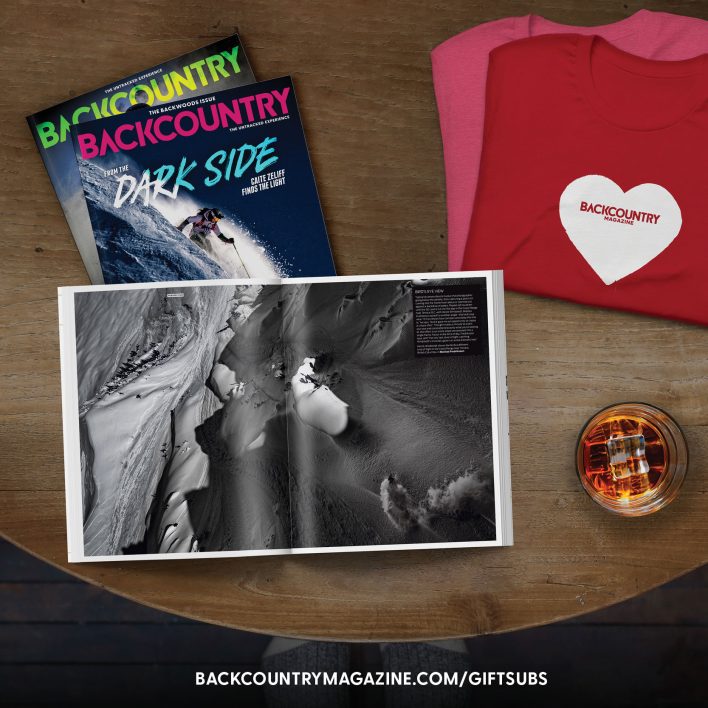In mid-April, Eric Layton, owner and lead guide for Splitboard Guides International, completed his AMGA exam—on a splitboard. This winter was the first season that snowboarders were able to take the course exam on something other than skis, although snowboards have been allowed in the course for the past several years. “Some people think, ‘Oh, splitboarding is just these guys going up there and putting their boards together and building kickers,'” Layton says. “But really we’re utilizing those splitboards to access bigger and steeper mountains.” A few weeks after he became one of the first guides to complete his AMGA Ski Guide Exam on a splitboard, we caught up with Layton to discuss splitboard progression, his exam and the scholarship that helped him get there.
Backcountry Magazine: What was your experience of taking the AMGA exam on a splitboard? Where there challenges, in terms of technique, during the exam?Eric Layton: It was an eight-day exam, so you’re kind of on the spot for the whole eight days that you’re guiding, as opposed to the other ones that are course-based and instructional-based. It was good. It really felt like guiding for real, so there were definitely a lot of challenges, but it seemed to flow for me. I had a really good course so it was an outcome of that.
I’m using hard boots nowadays and a different type of split system called the Phantom Split System and the Phantom Splitboard Bindings. They’re really easy to transition; they’re really fast. Then with the TLT hard boots that I’m using, I can ski what I need to and I can still skin. On steeper skinning I can have better edge control, so I can keep up and not slog so much like [when] splitboarding in soft boots. The bridge is being gapped so much with splitboarders and skiers that there really wasn’t too much of a difference [in the exam]. I think, where it comes down to it, how you guide a splitboarder might not be how you guide a skier. You know, a little different path because we don’t want to traverse as much. But I say, all in all, the bridge has definitely been gapped.
BCM: What does this opportunity mean in terms of how splitboarding is perceived?
EL: I think it definitely put it on the map on a professional level. People are understanding you’re adapting [splitboarding] to the ski mountaineering specifics, like going the hard-boot route; going with these new types of bindings, and you can still skin the exact same way with the Dynafit toepieces. I think it’s all of a sudden becoming recognized as a useful tool as opposed to an inferior tool. People are really digging it. Splitboard mountaineering is a sport. Some people think, “Oh, splitboarding is just these guys going up there and putting their boards together and building kickers.” But really we’re utilizing those splitboards to access bigger and steeper mountains.
It has it’s drawbacks, like anything else. It’s still not quite a ski, but I think in the years to come it will ski more like a ski and act more like a ski. That bridge will be gapped. There’s still that little two percent that’s missing. Like a 168 is pretty big snowboard, and a 168 ski is quite little. So with sidehilling, the skinning technique is a little different, but eventually they’re going to be able to bridge that, to utilize a smaller board and still be able to track like a ski.
BCM: It will be exciting to see how the technology progresses over the next couple of years, especially now that you can take the exam on a splitboard.
EL: It’s going to open up so many doors for people, which is going to be really cool. People stayed away for so long, who wanted to get into guiding but didn’t go the guiding route. It’s going to be neat to see and there’s going to be a market for it for years to come.
BCM: Do you think this certification will have any impact on your guiding company?
EL: Just like anything else, being certified is a great tool to have. It’s just like having your diploma. There are a lot of guides out there who just haven’t gone the certified way: it’s money, it’s time, it’s effort. But I think as far as trying to own an established business, one that has a good foundation, you really need to be a certified guide.
BCM: Absolutely. And you received the Rick Gaukel scholarship to complete the course, right?
EL: I did. I got the Rick Gaukel, with the Friends of Rick Gaukel Everywhere Splitboard Guide Scholarship, which is the first [splitboard scholarship] AMGA offered, ever.
BCM: Congratulations.
EL: Thanks, it’s a really cool thing. Rick was always trying to go to the AMGA office and write letters and, just like myself and other splitboarders out there, trying to get it part of the program. They just didn’t want to have anything to do with that. A lot of the snowboarders actually started to ski again, because we were going to just go through the process on skis, myself included; get the certification and then switch over and become a snowboard guide. Still, Rick was definitely writing letters all the time and stopping by the office and questioning them on why they wouldn’t do it, so it’s neat.
BCM: Brendan Burns has also taken the AMGA exam on a splitboard, but at the Chamonix Exam. Do you know of any other splitboarders who are seriously considering taking the exam on a splitboard at this point?
EL: Yeah, absolutely. There’s a couple guys. There are two splitboarders that I know of who just took their Aspirant Exam on a splitboard right here in Whistler, so that was cool. And there’s definitely another two or three that I personally know who have taken their ski guide. I think all in all there’s going to be a dozen of them going for it in the next year or so.











Related posts: